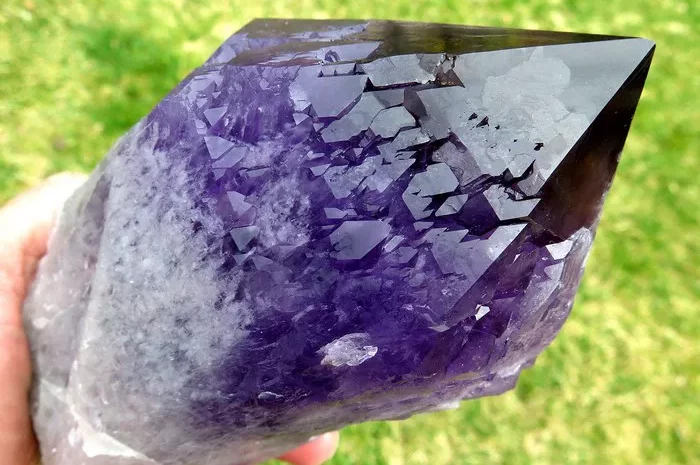Amethyst is a captivating gemstone known for its stunning purple color and rich symbolism. Revered for centuries by cultures around the world, amethyst has been associated with various qualities, virtues, and mystical properties. From ancient civilizations to modern-day spiritual practices, amethyst holds a special place in the hearts and minds of people seeking healing, protection, and spiritual enlightenment. In this article, we will explore the deep symbolism and significance of amethyst and what it represents to different cultures and beliefs.
Understanding Amethyst
Amethyst is a variety of quartz that ranges in color from pale lavender to deep purple. Its vibrant purple hue is caused by trace amounts of iron within the crystal structure. Amethyst has been cherished throughout history for its beauty and rarity, with some of the finest specimens originating from locations such as Brazil, Uruguay, and Zambia.
In addition to its aesthetic appeal, amethyst is associated with various metaphysical properties and healing benefits. It is believed to have a calming and purifying effect on the mind, body, and spirit, promoting balance, harmony, and spiritual growth. Amethyst is also associated with the crown chakra, the energy center located at the top of the head, which is believed to govern spiritual enlightenment, intuition, and higher consciousness.
What Does Amethyst Represent?
Amethyst has been imbued with symbolism and meaning by cultures around the world for millennia. Here are some of the most common symbolic meanings associated with amethyst:
Spirituality: Amethyst is often regarded as a stone of spirituality and enlightenment. Its deep purple color is said to resonate with the energy of the crown chakra, facilitating connection to the divine and higher realms of consciousness. Amethyst is believed to enhance meditation, intuition, and spiritual awareness, making it a powerful tool for spiritual seekers and practitioners.
Protection: Throughout history, amethyst has been revered for its protective properties. It is said to create a shield of spiritual protection around the wearer, warding off negative energy, psychic attacks, and harmful influences. Amethyst is often used as a talisman or amulet for protection during travel, meditation, and spiritual rituals.
Healing: Amethyst is associated with healing and purification on all levels – physical, emotional, mental, and spiritual. It is believed to have a calming and soothing effect on the nervous system, reducing stress, anxiety, and tension. Amethyst is also said to promote restful sleep, relieve headaches, and enhance overall well-being.
Wisdom: Amethyst is considered a stone of wisdom and enlightenment, inspiring clarity, insight, and higher consciousness. It is said to enhance mental clarity, concentration, and decision-making, making it an ideal stone for students, scholars, and anyone seeking greater understanding and wisdom.
Sobriety: In ancient times, amethyst was believed to have the power to prevent intoxication and promote sobriety. Its name is derived from the Greek word “amethystos,” which means “not intoxicated.” Amethyst was often worn or carried as a protective amulet by those seeking to overcome addiction or unhealthy habits.
Royalty and Nobility: In many cultures, amethyst has been associated with royalty, nobility, and divine power. It was once considered a “gem of kings” and was often used in royal jewelry and regalia. Amethyst’s deep purple color was seen as a symbol of wealth, power, and prestige.
The Cultural Significance of Amethyst
Amethyst holds special significance in various cultures and spiritual traditions around the world. Here are some examples of how amethyst is revered and utilized in different cultures:
Ancient Egypt: In ancient Egypt, amethyst was associated with the god Osiris and was often used in burial rituals and ceremonies. It was believed to have protective and healing properties and was worn as an amulet to ward off evil spirits and negative energy.
Greek and Roman Mythology: In Greek and Roman mythology, amethyst was associated with Dionysus, the god of wine and revelry. According to legend, Dionysus was angered by an insult and vowed to unleash tigers on the next person he encountered. A young maiden named Amethyst, who was on her way to worship the goddess Diana, was saved from the tigers by Diana, who turned her into a pillar of pure quartz to protect her from harm. When Dionysus saw what had happened, he wept tears of wine, which stained the quartz purple, creating the gemstone we know today as amethyst.
Native American Traditions: Native American tribes, such as the Cherokee and Apache, have long revered amethyst for its healing and protective properties. It was often used in spiritual ceremonies, rituals, and vision quests to promote clarity, insight, and spiritual growth.
Conclusion
Amethyst is a multifaceted gemstone that represents a myriad of qualities, virtues, and mystical properties. From spirituality and protection to healing and wisdom, amethyst holds deep symbolism and significance for cultures around the world. Whether you wear amethyst jewelry, meditate with amethyst crystals, or use amethyst in rituals and ceremonies, you can harness the power of this sacred stone to enhance your life and spiritual journey. By understanding the symbolism of amethyst and incorporating it into your practices, you can tap into its transformative energy and experience greater clarity, harmony, and spiritual growth.


